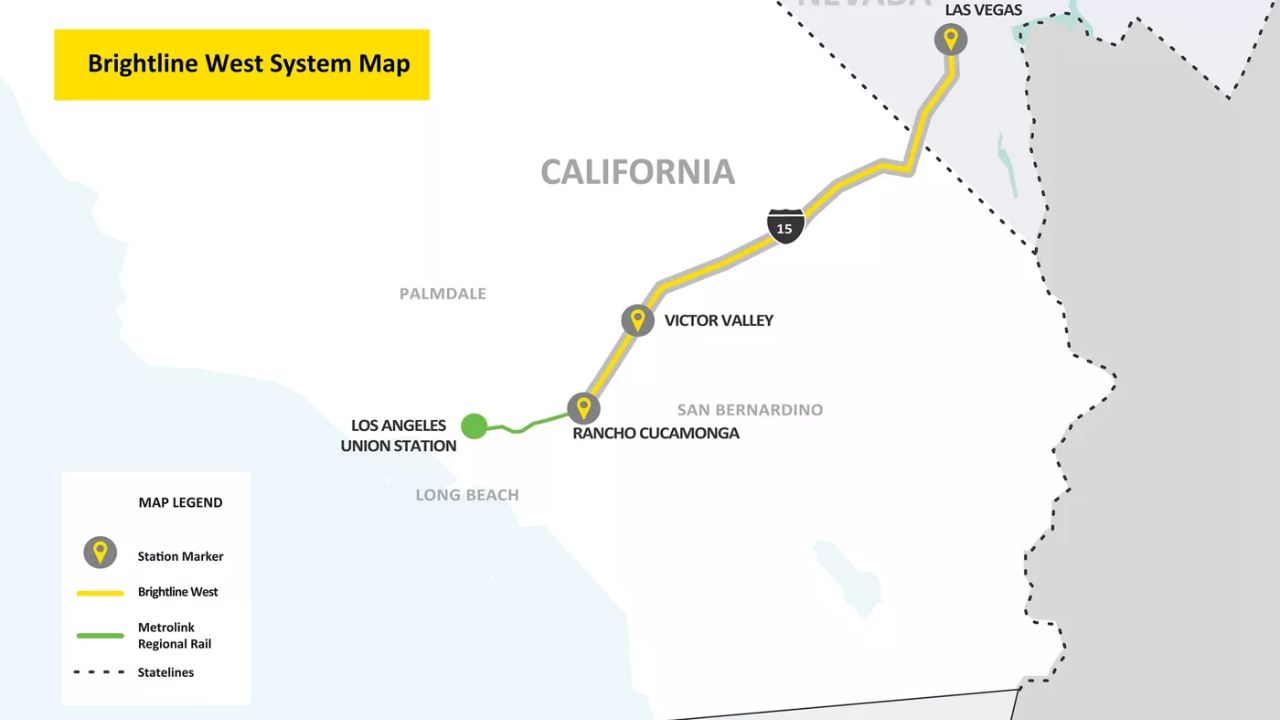Imagine traveling from Los Angeles to Las Vegas in less than three hours, without having to deal with traffic, congestion, or emissions. That is the vision of Brightline West, a proposed privately run high-speed rail project that aims to connect the two major cities through the California high desert.
Brightline West, formerly known as XpressWest, is a subsidiary of Fortress Investment Group, which also operates Brightline Florida, the first privately-owned and financed passenger rail project in the United States in decades. Brightline West plans to build a 218-mile electrified line that will run mostly within the median of the Interstate 15 highway, from Rancho Cucamonga in the Greater Los Angeles area to Las Vegas in Nevada.
The project is expected to break ground in early 2024 and cost about $8 billion, which will be funded by private investors and bonds. The trains will be capable of reaching speeds of up to 200 mph, making the trip in about 2 hours and 10 minutes, twice as fast as the normal drive time. The project will also have environmental and economic benefits, such as reducing greenhouse gas emissions, creating jobs, and stimulating tourism.
Benefits of Brightline West
Brightline West will offer a fast, simple, and clean alternative to the current travel options between Los Angeles and Las Vegas, which are mainly by car or plane. According to the project website, there are nearly 50 million annual trips between the two cities, over 85% of them by car. The drive can take up to 7 hours or more during the weekend rush, and is unpredictable, unreliable, and challenged by congestion.
By contrast, Brightline West will provide a reliable and comfortable service, with state-of-the-art amenities, such as Wi-Fi, food and beverage, and entertainment. The trains will be fully electric, powered largely by emission-free sources, and will reduce carbon dioxide emissions by 400,000 tons per year. The project will also reduce vehicle miles traveled by 700 million per year, and save 40 million gallons of gasoline per year.
In addition, Brightline West will generate significant economic impacts, such as creating 35,000 construction jobs, 1,000 permanent jobs, and $10 billion in economic activity. The project will also generate $1 billion in tax revenues, and support the development of transit-oriented communities along the corridor. Moreover, Brightline West will boost the tourism and entertainment industries in both Los Angeles and Las Vegas, by making them more accessible and attractive to visitors.
Connectivity and Integration
Brightline West will not only connect Los Angeles and Las Vegas, but also integrate with the existing and planned transportation networks in the region. At Rancho Cucamonga, the Los Angeles area station, Brightline West will connect with Metrolink, the regional rail system that serves over 60 stations in Southern California, including Los Angeles Union Station. Passengers will also be able to access local transit, rideshare, micro-mobility, and Brightline’s own last-mile ride service, Brightline+.
At Las Vegas, the station will be located near the Strip, the main tourist attraction in the city. Brightline West will also provide shuttles to and from the major resorts, as well as connections to local transit and other modes of transportation.
Furthermore, Brightline West is designed to accommodate future extensions and expansions, such as the High-Desert Corridor, a proposed highway and rail project that would link Rancho Cucamonga with Palmdale, where passengers could access another Metrolink line and the California High-Speed Rail system. This would enable a one-seat ride from Las Vegas to San Francisco, and other destinations in the state.
Conclusion
Brightline West is a visionary and ambitious project that will transform the travel experience between Los Angeles and Las Vegas, two of the most iconic and dynamic cities in the United States. The project will offer a fast, simple, and clean alternative to the current options, and will also have positive impacts on the environment, the economy, and the quality of life of the people in the region. Brightline West will also integrate with the existing and planned transportation networks, and will pave the way for more high-speed rail projects in the country. Brightline West is expected to start construction in early 2024, and to begin operations in 2026.
